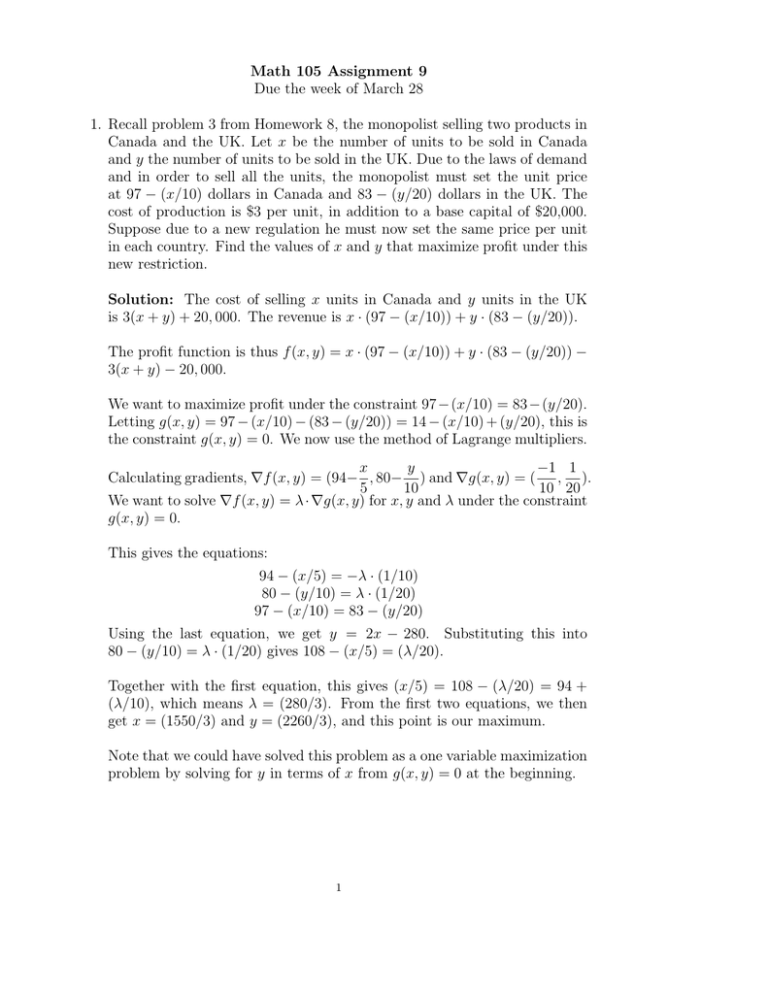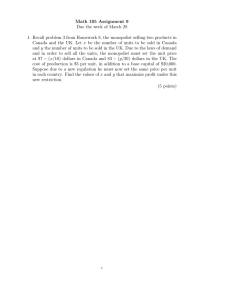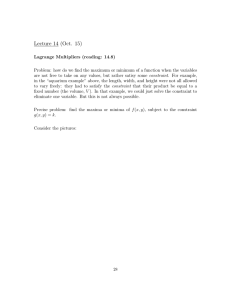Math 105 Assignment 9 Due the week of March 28
advertisement

Math 105 Assignment 9 Due the week of March 28 1. Recall problem 3 from Homework 8, the monopolist selling two products in Canada and the UK. Let x be the number of units to be sold in Canada and y the number of units to be sold in the UK. Due to the laws of demand and in order to sell all the units, the monopolist must set the unit price at 97 − (x/10) dollars in Canada and 83 − (y/20) dollars in the UK. The cost of production is $3 per unit, in addition to a base capital of $20,000. Suppose due to a new regulation he must now set the same price per unit in each country. Find the values of x and y that maximize profit under this new restriction. Solution: The cost of selling x units in Canada and y units in the UK is 3(x + y) + 20, 000. The revenue is x · (97 − (x/10)) + y · (83 − (y/20)). The profit function is thus f (x, y) = x · (97 − (x/10)) + y · (83 − (y/20)) − 3(x + y) − 20, 000. We want to maximize profit under the constraint 97 − (x/10) = 83 − (y/20). Letting g(x, y) = 97 − (x/10) − (83 − (y/20)) = 14 − (x/10) + (y/20), this is the constraint g(x, y) = 0. We now use the method of Lagrange multipliers. x y −1 1 Calculating gradients, ∇f (x, y) = (94− , 80− ) and ∇g(x, y) = ( , ). 5 10 10 20 We want to solve ∇f (x, y) = λ · ∇g(x, y) for x, y and λ under the constraint g(x, y) = 0. This gives the equations: 94 − (x/5) = −λ · (1/10) 80 − (y/10) = λ · (1/20) 97 − (x/10) = 83 − (y/20) Using the last equation, we get y = 2x − 280. Substituting this into 80 − (y/10) = λ · (1/20) gives 108 − (x/5) = (λ/20). Together with the first equation, this gives (x/5) = 108 − (λ/20) = 94 + (λ/10), which means λ = (280/3). From the first two equations, we then get x = (1550/3) and y = (2260/3), and this point is our maximum. Note that we could have solved this problem as a one variable maximization problem by solving for y in terms of x from g(x, y) = 0 at the beginning. 1 2 2. Suppose that a firm makes two products A and B that use the same raw materials. Given a fixed amount of raw materials and a fixed amount of manpower, the firm must decide how much of its resources should be allocated to the production of A and how much to B. The management is aware of the production possibilities curve 9x2 + 4y 2 = 18, 000 which reflects the limitations on personnel and raw materials available to the firm. A point (x, y) on this curve is called a production schedule for the firm, committing it to produce x units of A and y units of B. The sale of each unit of A yields a $3 profit, whereas each unit of B yields a $4 profit. Assuming that all units produced are sold, find the production schedule that maximizes the profit of the firm. Solution: The profit function is f (x, y) = 3x + 4y and the constraint is g(x, y) = 9x2 + 4y 2 − 18, 000 = 0. We use the method of Lagrange multipliers again. The gradient of f is ∇f (x, y) = (3, 4) and the gradient of g is g(x, y) = (18x, 8y). We want to find x, y and λ with ∇f (x, y) = λ · ∇g(x, y). The equations to solve are: 3 = λ18x 4 = λ8y 18, 000 = 9x2 + 4y 2 Note that λ 6= 0 since this would give 3 = λ18x = 0, so we can divide by λ 1 1 on both sides of the first and second equations to get x = 6λ and y = 2λ . 1 1 5 Plugging this into the third equation gives 18, 000 = 9( )2 +4( )2 = 2 , 6λ 2λ 4λ 1 so λ = ± . 120 The critical points to check are then (x, y) = (20, 60) and (−20, −60), and (20, 60) is our maximum. 3 3. Roger is breeding tropical fish to sell to hobbyists. He feels that his supply curve looks like y1 = 0.06x2 + 5, where x is the number of fish, in hundreds, sold at y1 dollars each. Articles in his trade newsletters lead him to believe that the demand curve is y2 = 0.2x2 − 4.8x + 31.8. (a) Calculate the producer surplus if Roger sells at y1 (7). (b) What is the consumer surplus? Solution: (a) The producer surplus is the area between the curves f (x) = 0.06x2 + 5 and g(x) = y1 (7) from x = 0 to x = 7. Z 7 Z 7 (y1 (7) − y1 (x))dx = (−0.06x2 + 2.94)dx = This is the integral CS = 0 0 13.72 (b) The consumer surplus is the area between the curves f (x) = y2 (x) = 0.2x2 − 4.8x + 31.8 and g(x) = y1 (7) = 7.94 from x = 0 to x = 7. Z 7 Z 7 (0.2x2 −4.8x+23.86) = (y2 (x)−y1 (7))dx = This is the integral PS = 72.2867 0 0




